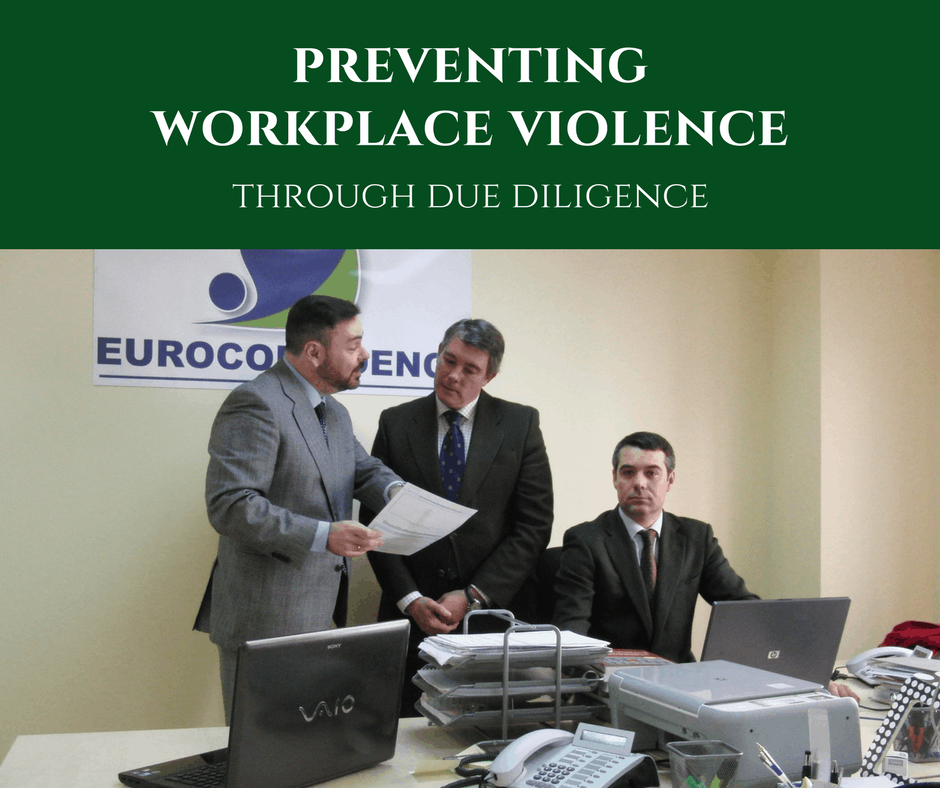6 Ways To Prevent Workplace Violence Through Due Diligence

Preventing Workplace Violence Through Due Diligence Protects Your Employees
It’s a tragic story that we have heard all too often in the recent past–an employee, disgruntled for reasons related or unrelated to their employer, with access to weapons of some kind, goes on a rampage and hurts or kills co-workers, family members, or strangers at their place of employment. These sorts of horrific events seem like they are impossible to prevent. Interviews after such incidents suggest that some people might have known the employee was unhappy, but most of the time, no one would have imagined such tragedies unfolding.
While it’s true that knowing who might snap and when is nearly impossible, employers aren’t helpless when it comes to preventing workplace violence. Knowing more about your employees before you bring them onboard is a critical step in building a healthy workplace.
Here are six key steps that your company can take to safeguard against workplace violence.
1. Conduct thorough pre-employment screenings.
While this might seem obvious, all too often, companies don’t do their due diligence prior to onboarding new employees. A thorough background investigation can help bring to light issues like past criminal convictions, a history of financial instability, attitude problems in past positions, or false assertions on an employment application. Any of these problems should raise red flags for employers, as they can point to signs of larger issues.
2. Get to know who the employee is when they’re outside of the workplace.
Alliance Risk Group CEO Mario Pecoraro spoke at the RIMS (Risk Management Society) conference in Philadelphia early in 2017 on the topic of workplace violence. One of the key things he encouraged employers to take note of was the employee’s out-of-work behavior. “Workplace violence is not just about an employee who’s angry,” Pecoraro explained. “It’s also about the domestic side that’s often overlooked.”
Does the employee frequently speak with coworkers about things going on at home? Employees who are more of a risk tend to withhold personal information in normal social interactions. If an employee seems to always have a negative attitude, that can be another sign that something is wrong. Reaching out to employees who seem distant or upset can go a long way towards identifying problems before they occur.
3. Pay attention to workplace violence trends.
Pecoraro’s lecture at the RIMS conference was summarized in the October issue of Rough Notes, a publication for insurance industry professionals. The article explains that workplace violence trends can be a powerful tool for early detection. Here are some common traits of violent aggressors in the workplace:
- Under the age of 40
- Lacks social skills
- Stays in the background and won’t confront challenges
- Has difficulty making eye contact
- Is a victim of teasing or bullying
- Responds poorly to criticism
- Blames and threatens others
- Has emotional outbursts and/or is emotionally charged
- Is generally depressed
- Has conflicts with coworkers
4. If you see something, say something.
All too often, employers, coworkers, neighbors, or family members speak up after a tragedy and suggest that they aren’t surprised. In the case of numerous recent violent workplace attacks, the aggressor had been fired, had previous outbursts at work, or was reported for inappropriate behavior. In some instances, reports of these findings didn’t make it into background checks because they were improperly documented or not taken seriously.
5. Continue background investigations after an employee is hired.
As an employer, you have a right to conduct additional background investigations post-hire. Just because an employee had a clean record at their date of hire doesn’t mean problematic incidents haven’t occurred since. Keep up-to-date on employees’ social media, too. Posts can be an indicator of changes in mindset or circumstance.
6. Have a plan.
If something comes up that worries you, have a plan in place. Security measures to deal with employees whose behavior concerns you are crucial to have in place ahead of an incident. Be sure all members of the management team are on the same page when it comes to dealing with the perceived threat, and make arrangements to exit the employee as soon as possible. If appropriate, alert the proper authorities to any evidence of attempted or planned violent acts.
Unfortunately, firing the employee alone might not negate the danger. Many instances of workplace violence arise as a result of disgruntled ex-employees returning to seek revenge. Instruct employees to verify the purpose of any office visitors and to immediately report anything suspicious. Until you know the intent of a visitor, do not let them in. Use a lock and buzzer system to keep the office secure. Also ensure that all employees are familiar with emergency contact information and an office evacuation strategy.
Your company can never be too careful when it comes to safety. Know who you’re hiring and continue to perform regular background investigations. Have plans in place for what to do if things go wrong. By employing many security measures and being proactive, your company will be far better prepared to avoid a workplace violence scenario.
